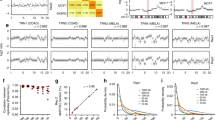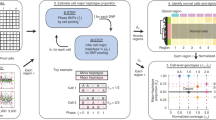Abstract
Gene amplifications and deletions frequently contribute to tumorigenesis. Characterization of these DNA copy-number changes is important for both the basic understanding of cancer and its diagnosis. Comparative genomic hybridization (CGH) was developed to survey DNA copy-number variations across a whole genome1. With CGH, differentially labelled test and reference genomic DNAs are co-hybridized to normal metaphase chromosomes, and fluorescence ratios along the length of chromosomes provide a cytogenetic representation of DNA copy-number variation. CGH, however, has a limited (~20 Mb) mapping resolution, and higher-resolution techniques, such as fluorescence in situ hybridization (FISH), are prohibitively labour-intensive on a genomic scale. Array-based CGH, in which fluorescence ratios at arrayed DNA elements provide a locus-by-locus measure of DNA copy-number variation, represents another means of achieving increased mapping resolution2,3,4. Published array CGH methods have relied on large genomic clone (for example BAC) array targets and have covered only a small fraction of the human genome. cDNAs representing over 30,000 radiation-hybrid (RH)–mapped human genes5,6 provide an alternative and readily available genomic resource for mapping DNA copy-number changes. Although cDNA microarrays have been used extensively to characterize variation in human gene expression7,8,9, human genomic DNA is a far more complex mixture than the mRNA representation of human cells. Therefore, analysis of DNA copy-number variation using cDNA microarrays would require a sensitivity of detection an order of magnitude greater than has been routinely reported7. We describe here a cDNA microarray-based CGH method, and its application to DNA copy-number variation analysis in breast cancer cell lines and tumours. Using this assay, we were able to identify gene amplifications and deletions genome-wide and with high resolution, and compare alterations in DNA copy number and gene expression.
This is a preview of subscription content, access via your institution
Access options
Subscribe to this journal
Receive 12 print issues and online access
$209.00 per year
only $17.42 per issue
Buy this article
- Purchase on Springer Link
- Instant access to full article PDF
Prices may be subject to local taxes which are calculated during checkout





Similar content being viewed by others
References
Kallioniemi, A. et al. Comparative genomic hybridization for molecular cytogenetic analysis of solid tumors. Science 258, 818–821 (1992).
Solinas-Toldo, S. et al. Matrix-based comparative genomic hybridization: biochips to screen for genomic imbalances. Genes Chromosomes Cancer 20, 399–407 (1997).
Pinkel, D. et al. High resolution analysis of DNA copy number variation using comparative genomic hybridization to microarrays. Nature Genet. 20, 207–211 (1998).
Geschwind, D.H. et al. Klinefelter's syndrome as a model of anomalous cerebral laterality: testing gene dosage in the X chromosome pseudoautosomal region using a DNA microarray. Dev. Genet. 23, 215–229 (1998).
Schuler, G.D. et al. A gene map of the human genome. Science 274, 540–546 (1996).
Deloukas, P. et al. A physical map of 30,000 human genes. Science 282, 744–746 (1998).
Schena, M., Shalon, D., Davis, R.W. & Brown, P.O. Quantitative monitoring of gene expression patterns with a complementary DNA microarray. Science 270, 467–470 (1995).
DeRisi, J. et al. Use of a cDNA microarray to analyse gene expression patterns in human cancer. Nature Genet. 14, 457–460 (1996).
Iyer, V. et al. The transcriptional program in the response of human fibroblasts to serum. Science 283, 83–87 (1999).
Kallioniemi, O.P. et al. ERBB2 amplification in breast cancer analyzed by fluorescence in situ hybridization. Proc. Natl Acad. Sci. USA 89, 5321–5325 (1992).
Lucito, R. et al. Genetic analysis using genomic representations. Proc. Natl Acad. Sci. USA 95, 4487–4492 (1998).
Gyapay, G. et al. A radiation hybrid map of the human genome. Hum. Mol. Genet. 5, 339–346 (1996).
Kallioniemi A. et al. Detection and mapping of amplified DNA sequences in breast cancer by comparative genomic hybridization. Proc. Natl Acad. Sci. USA 91, 2156–2160 (1994).
Gelmini, S. et al. Quantitative polymerase chain reaction-based homogeneous assay with fluorogenic probes to measure c-erbB-2 oncogene amplification. Clin. Chem. 43, 752–758 (1997).
Barlund, M. et al. Increased copy number at 17q22–q24 by CGH in breast cancer is due to high-level amplification of two separate regions. Genes Chromosomes Cancer 20, 372–376 (1997).
Kallioniemi, O.P. et al. Optimizing comparative genomic hybridization for analysis of DNA sequence copy number changes in solid tumors. Genes Chromosomes Cancer 10, 231–243 (1994).
Stein, D. et al. The SH2 domain protein GRB-7 is co-amplified, overexpressed and in a tight complex with HER2 in breast cancer. EMBO J. 13, 1331–1340 (1994).
Tomasetto C. et al. Identification of four novel human genes amplified and overexpressed in breast carcinoma and localized to the q11–q21.3 region of chromosome 17. Genomics 28, 367–376 (1995).
Guan, X.Y. et al. Hybrid selection of transcribed sequences from microdissected DNA: isolation of genes within amplified region at 20q11–q13.2 in breast cancer. Cancer Res. 56, 3446–3450 (1996).
Anzick, S.L. et al. AIB1, a steroid receptor coactivator amplified in breast and ovarian cancer. Science 277, 965–968 (1997).
Williamson, J.A. et al. Chromosomal mapping of the human and mouse homologues of two new members of the AP-2 family of transcription factors. Genomics 35, 262–264 (1996).
Sen, S., Zhou, H. & White, R.A. A putative serine/threonine kinase encoding gene BTAK on chromosome 20q13 is amplified and overexpressed in human breast cancer cell lines. Oncogene 14, 2195–2200 (1997).
Shalon, D., Smith, S.J. & Brown, P.O. A DNA microarray system for analyzing complex DNA samples using two-color fluorescent probe hybridization. Genome Res. 6, 639–645 (1996).
DeRisi, J.L., Iyer, V.R. & Brown, P.O. Exploring the metabolic and genetic control of gene expression on a genomic scale. Science 278, 680–686 (1997).
Lennon, G., Auffray, C., Polymeropoulos, M. & Soares, M.B. The I.M.A.G.E. Consortium: an integrated molecular analysis of genomes and their expression. Genomics 33, 151–152 (1996).
Boguski, M.S. & Schuler, G.D. ESTablishing a human transcript map. Nature Genet. 10, 369–371 (1995).
Schuler, G.D. Pieces of the puzzle: expressed sequence tags and the catalog of human genes. J. Mol. Med. 75, 694–698 (1997).
Alitalo, K., Schwab, M., Lin, C.C., Varmus, H.E. & Bishop, J.M. Homogeneously staining chromosomal regions contain amplified copies of an abundantly expressed cellular oncogene (c-myc) in malignant neuroendocrine cells from a human colon carcinoma. Proc. Natl Acad. Sci. USA 80, 1707–1711 (1983).
Takahashi, T. et al. p53: a frequent target for genetic abnormalities in lung cancer. Science 246, 491–494 (1989).
Saxena, R. et al. The DAZ gene cluster on the human Y chromosome arose from an autosomal gene that was transposed, repeatedly amplified and pruned. Nature Genet. 14, 292–299 (1996).
Acknowledgements
We thank K. Ranade for assistance with quantitative PCR analysis; R. Sutton, C. Rees and members of the Brown and Botstein Labs for helpful discussions; and J. Doda for human mitochondrial DNA. This work was supported by grants from the National Cancer Institute, the National Human Genome Research Institute and the Howard Hughes Medical Institute. J.R.P. is a Physician Postdoctoral Fellow and P.O.B. is an Associate Investigator of the Howard Hughes Medical Institute. C.M.P. is a SmithKline Beecham Pharmaceuticals Fellow of the Life Sciences Research Foundation. M.B.E. is supported by a postdoctoral fellowship from the Alfred E. Sloan Foundation.
Author information
Authors and Affiliations
Corresponding author
Rights and permissions
About this article
Cite this article
Pollack, J., Perou, C., Alizadeh, A. et al. Genome-wide analysis of DNA copy-number changes using cDNA microarrays. Nat Genet 23, 41–46 (1999). https://doi.org/10.1038/12640
Received:
Accepted:
Issue Date:
DOI: https://doi.org/10.1038/12640
This article is cited by
-
Pharmacogenetic profiling and individualised therapy in the treatment of degenerative spinal conditions
Irish Journal of Medical Science (1971 -) (2023)
-
Colorectal cancer concurrent gene signature based on coherent patterns between genomic and transcriptional alterations
BMC Cancer (2022)
-
Fish genomics and its impact on fundamental and applied research of vertebrate biology
Reviews in Fish Biology and Fisheries (2022)
-
Sequence-selective dynamic covalent assembly of information-bearing oligomers
Nature Communications (2020)
-
Through the looking glass and what you find there: making sense of comparative genomic hybridization and fluorescence in situ hybridization for melanoma diagnosis
Modern Pathology (2020)



